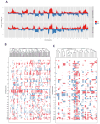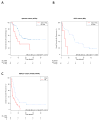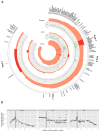Integrative analysis of 1q23.3 copy-number gain in metastatic urothelial carcinoma
- PMID: 24486590
- PMCID: PMC3975677
- DOI: 10.1158/1078-0432.CCR-13-0759
Integrative analysis of 1q23.3 copy-number gain in metastatic urothelial carcinoma
Abstract
Purpose: Metastatic urothelial carcinoma of the bladder is associated with multiple somatic copy-number alterations (SCNAs). We evaluated SCNAs to identify predictors of poor survival in patients with metastatic urothelial carcinoma treated with platinum-based chemotherapy.
Experimental design: We obtained overall survival (OS) and array DNA copy-number data from patients with metastatic urothelial carcinoma in two cohorts. Associations between recurrent SCNAs and OS were determined by a Cox proportional hazard model adjusting for performance status and visceral disease. mRNA expression was evaluated for potential candidate genes by NanoString nCounter to identify transcripts from the region that are associated with copy-number gain. In addition, expression data from an independent cohort were used to identify candidate genes.
Results: Multiple areas of recurrent significant gains and losses were identified. Gain of 1q23.3 was independently associated with a shortened OS in both cohorts [adjusted HR, 2.96; 95% confidence interval (CI), 1.35-6.48; P = 0.01 and adjusted HR, 5.03; 95% CI, 1.43-17.73; P < 0.001]. The F11R, PFDN2, PPOX, USP21, and DEDD genes, all located on 1q23.3, were closely associated with poor outcome.
Conclusions: 1q23.3 copy-number gain displayed association with poor survival in two cohorts of metastatic urothelial carcinoma. The identification of the target of this copy-number gain is ongoing, and exploration of this finding in other disease states may be useful for the early identification of patients with poor-risk urothelial carcinoma. Prospective validation of the survival association is necessary to demonstrate clinical relevance.
©2014 AACR.
Figures



References
-
- Siegel R, Naishadham D, Jemal A. Cancer statistics, 2013. CA Cancer J Clin. 2013;63:11–30. - PubMed
-
- Loehrer PJ, Sr, Einhorn LH, Elson PJ, Crawford ED, Kuebler P, Tannock I, et al. A randomized comparison of cisplatin alone or in combination with methotrexate, vinblastine, and doxorubicin in patients with metastatic urothelial carcinoma: a cooperative group study. J Clin Oncol. 1992;10:1066–73. - PubMed
-
- Bajorin DF, Dodd PM, Mazumdar M, Fazzari M, McCaffrey JA, Scher HI, et al. Long-term survival in metastatic transitional-cell carcinoma and prognostic factors predicting outcome of therapy. J Clin Oncol. 1999;17:3173–81. - PubMed
-
- Bellmunt J, Choueiri TK, Fougeray R, Schutz FA, Salhi Y, Winquist E, et al. Prognostic factors in patients with advanced transitional cell carcinoma of the urothelial tract experiencing treatment failure with platinum-containing regimens. J Clin Oncol. 2010;28:1850–5. - PubMed
-
- Hurst CD, Fiegler H, Carr P, Williams S, Carter NP, Knowles MA. High-resolution analysis of genomic copy number alterations in bladder cancer by microarray-based comparative genomic hybridization. Oncogene. 2004;23:2250–63. - PubMed
Publication types
MeSH terms
Grants and funding
LinkOut - more resources
Full Text Sources
Other Literature Sources
Medical
Molecular Biology Databases

